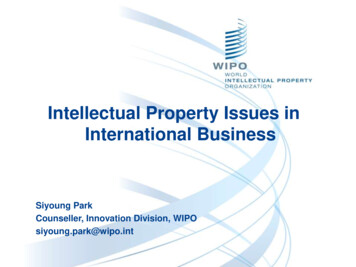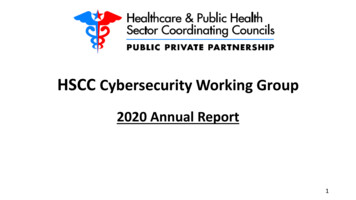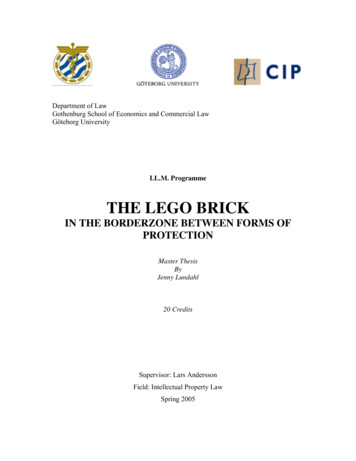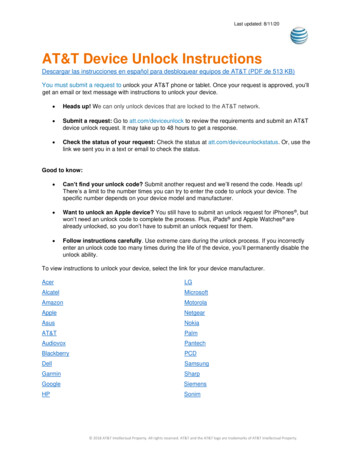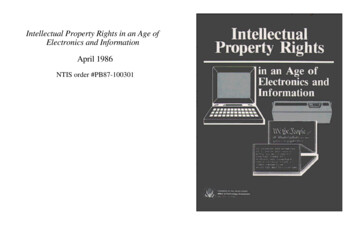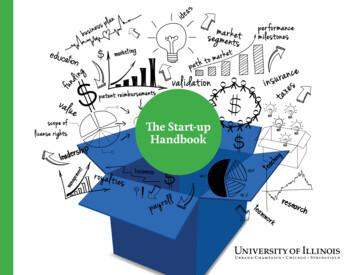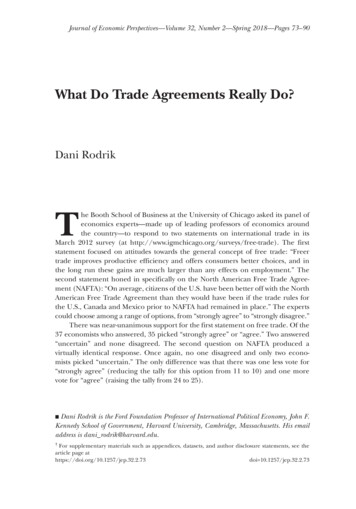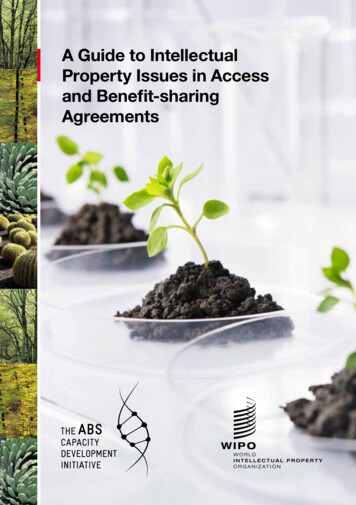
Transcription
A Guide to IntellectualProperty Issues in Accessand Benefit-sharingAgreements
This publication was prepared by the Traditional KnowledgeDivision of the World Intellectual Property Organization(WIPO) and the ABS Capacity Development Initiative. Thelead authors are Maria Julia Oliva, Senior Coordinator forPolicy and Technical Support, Union for Ethical BioTrade(UEBT), and Olivier Rukundo, Legal Expert on access andbenefit-sharing and intellectual property, both consultants toWIPO and whose work was guided and coordinated by DaphneZografos-Johnsson. Shakeel Bhatti guided and coordinatedthe later phases of the finalization of this publication. Supportand comments were provided by Wend Wendland, HartmutMeyer, Kathrin Heidbrink, Claudio Chiarolla, Lena Fey, AliceManero and Rhona Rwangyezi. Special thanks are due toPierre du Plessis, Rachel Wynberg and Tomme Young forpeer-reviewing the first draft. The final draft was peer-reviewedby David Muls, Marco Aleman, Valérie Jouvin, Begoña Veneroand Thomas Dillon, and edited by Toby Boyd.About the multi-donor ABS CapacityDevelopment InitiativeThe ABS Capacity Development Initiative aims to contributeto poverty reduction, food security, technology transfer, socialdevelopment including equity and rights, and biodiversityconservation through implementing in its entirety the NagoyaProtocol on Access to Genetic Resources and the Fair andEquitable Sharing of Benefits Arising from their Utilizationto the Convention on Biological Diversity and the third objective of the Convention on Biological Diversity, namelythe fair and equitable sharing of benefits arising from theutilization of genetic resources. Established in 2006, the ABSCapacity Development Initiative is implemented by DeutscheGesellschaft für Internationale Zusammenarbeit (GIZ) GmbH,hosted by the Government of Germany, and co-funded byNorway, the Institut de la Francophonie pour le développementdurable (IFDD) and the European Union (EU).About the World Intellectual Property OrganizationWIPO is the United Nations specialized agency for intellectualproperty issues. Its mission is to lead the development of abalanced and effective international intellectual property(IP) system that enables innovation and creativity for thebenefit of all.
A Guide to IntellectualProperty Issues in Accessand Benefit-sharingAgreements
The user is allowed to reproduce, distribute, adapt, translateand publicly perform this publication, including for commercialpurposes, without explicit permission, provided that the contentis accompanied by an acknowledgement that WIPO is thesource and that it is clearly indicated if changes were madeto the original content.Suggested citation: World Intellectual Property Organization(WIPO) (2018) A Guide to Intellectual Property Issues inAccess and Benefit-sharing Agreements. WIPO: Geneva.Adaptation/translation/derivatives should not carry any official emblem or logo, unless they have been approved andvalidated by WIPO. Please contact us via the WIPO websiteto obtain permission.For any derivative work, please include the followingdisclaimer: “The Secretariat of WIPO and the ABS CapacityDevelopment Initiative assume no liability or responsibilitywith regard to the transformation or translation of the originalcontent”.When content published by WIPO, such as images, graphics,trademarks or logos, is attributed to a third party, the user ofsuch content is solely responsible for clearing the rights withthe right holder(s).To view a copy of this license, please igo/The designations employed and the presentation of materialthroughout this publication do not imply the expression ofany opinion whatsoever on the part of WIPO concerning thelegal status of any country, territory or area or of its authorities,or concerning the delimitation of its frontiers or boundaries. WIPO, 2018This publication is not intended to reflect the views of theMember States or the WIPO Secretariat.The mention of specific companies or products of manufacturers does not imply that they are endorsed or recommendedby WIPO in preference to others of a similar nature that arenot mentioned.Cover photo credit: Getty/pogonici.World Intellectual Property Organization34, chemin des Colombettes, P.O. Box 18CH-1211 Geneva 20, SwitzerlandAttribution 3.0 IGO license(CC BY 3.0 IGO)Printed in Switzerland
Table of contentsForewordFigures and boxesAcronymsExecutive summary1. IntroductionAbout this guide46783. Exploiting andmanaging IP rights46Non-commercialABS agreements4610Commercial ABSagreements4710Relevant internationalinstruments13Terminology usedin this guide162. IP rights in the contextof mutually agreedterms on ABS22Initial considerationsTypes of IP rightsthat can arise inthe utilization ofgenetic resources2226Change of intent and/ortransfer to third parties 49Ownership andlicensing of IP rights50Provisions for amicablesettlement of disputesrelating to IP rightsin ABS agreements554. Sector-specificIP Agriculture71Cosmetics andpersonal care78Food and beverages825. Concluding summary 873
ForewordGenetic resources are subject to access and benefit-sharing regulations,in particular within the international legal and policy framework definedby the Convention on Biological Diversity and its Nagoya Protocol onAccess to Genetic Resources and the Fair and Equitable Sharing ofBenefits Arising from their Utilization, the International Treaty on PlantGenetic Resources for Food and Agriculture of the United Nations Foodand Agriculture Organization and the Pandemic Influenza PreparednessFramework of the World Health Organization. Intellectual propertyissues are one of the elements of the broader framework on accessand equitable benefit-sharing. The strategic management of intellectualproperty issues in an access and benefit-sharing agreement caninfluence the degree to which providers and users of genetic resourcesand associated traditional knowledge can achieve their goals and servetheir mutual interests.In May 2010, during the Sixteenth Session of the IntergovernmentalCommittee on Intellectual Property and Genetic Resources, TraditionalKnowledge and Folklore (the IGC), the Secretariat of the World IntellectualProperty Organization (WIPO) was invited to prepare and make availablean updated version of the document entitled “Genetic Resources: DraftIntellectual Property Guidelines for Access and Benefit-sharing”. Thepresent guide, which has been prepared by WIPO in collaboration withthe ABS Capacity Development Initiative, builds upon that document.The guide, which is complementary and mutually supportive of the WIPOdatabase of biodiversity-related access and benefit-sharing agreements,covers the conceptual and practical aspects of dealing with intellectualproperty in the context of access and benefit-sharing agreements. Itsobjective is to support providers and users of genetic resources andassociated traditional knowledge when managing intellectual propertyissues in access and benefit-sharing agreements. It does so by explaininghow intellectual property clauses may influence the approach andresults of the utilization of genetic resources and associated traditionalknowledge, providing an overview of the types of intellectual propertyrelated issues that providers and users of genetic resources andassociated traditional knowledge are likely to face when negotiatingan agreement, and outlining the options available in managing thoseissues, thereby enhancing the information available to stakeholders.4
Finally, the guide draws on a number of practical experiences acrossa range of economic sectors, including pharmaceuticals, industrialbiotechnology, agriculture, cosmetics, and food and beverages, anddescribes issues that have arisen in practice in those sectors and thevarious approaches taken to resolving them.It is my hope that this guide will support both providers and users ofgenetic resources and associated traditional knowledge in negotiating,developing and drafting intellectual property clauses in mutually agreedterms on access and benefit-sharing, facilitate understanding andpromote practical solutions.Francis GURRYDirector General5
Figures and boxes6Figure 1: A minimal scheme for access to genetic resources21Box 1: Checklist for deciding whether or not to acquire IP rightsBox 2: Checklist for negotiating and obtaining IP rightsBox 3: Patents based on the utilization of genetic resources:the example of SalinosporamideBox 4: Sample clause on patentsBox 5: Sample clause on confidentialityBox 6: Checklist of patent-related issues to considerin ABS negotiationsBox 7: Sample clause restricting the use of a symbol associatedwith the resourcesBox 8: Checklist of trademark-related issues to considerin ABS negotiationsBox 9: Checklist of copyright-related issues to considerin ABS negotiationsBox 10: Sample clause on trade secretsBox 11: Trade secrets arising from the utilization of genetic resourcesBox 12: Checklist of trade secret-related issues to considerin ABS negotiationsBox 13: Sample clause restricting the claiming of IP rightsBox 14: Sample clause on change of intent from non-commercialto commercial utilizationBox 15: Sample clause defining what is being licensedBox 16: Sample clause granting an exclusive licenseBox 17: Sample clause identifying rights grantedBox 18: Sample clause specifying a royalty rateBox 19: Sample clauses on ownership of IP rights in thepharmaceutical sectorBox 20: Royalty rates in pharmaceutical and biotechnologylicensing agreementsBox 21: Crop protectionBox 22: Selected IP provisions in the SMTABox 23: Sample material transfer agreement provisionpreventing patentingBox 24: Sample material transfer agreement provisionon agricultural research and IPBox 25: Sample clause on non-disclosure usedin the cosmetics sectorBox 26: 737577778183
AcronymsABSCBDCGIARIPITPGRFAR&DSMTAWIPOaccess and benefit-sharingConvention on Biological Diversityformerly, the Consultative Group for International AgriculturalResearchintellectual propertyInternational Treaty on Plant Genetic Resources for Foodand Agricultureresearch and developmentStandard Material Transfer AgreementWorld Intellectual Property Organization7
Executive summaryThis guide describes how intellectual property (IP) issues arise innegotiations and agreements on access to genetic resources and thefair and equitable sharing of benefits arising from their utilization or, asit is widely known, ABS. It has been produced by the World IntellectualProperty Organization (WIPO) in cooperation with the ABS CapacityDevelopment Initiative.ABS is encouraged by several instruments of international law. TheConvention on Biological Diversity (CBD) recognizes the sovereign rightsof States over their natural resources and their authority to determineaccess to genetic resources in areas within their jurisdiction. The CBDestablishes key principles for regulating ABS, including that conditionsfor access to or utilization of genetic resources and the sharing of anyresulting benefits must be based on “mutually agreed terms”. The NagoyaProtocol on Access to Genetic Resources and the Fair and EquitableSharing of Benefits Arising from their Utilization (Nagoya Protocol), theInternational Treaty on Plant Genetic Resources for Food and Agriculture(ITPGRFA) and the WHO Pandemic Influenza Preparedness Frameworkare also essential references for negotiations and agreements on ABS.IP considerations often arise in negotiations or agreements on ABS. Forexample, this may occur because the proposed utilization of geneticresources is expected to lead to innovations or new knowledge thatmight be subject to IP rights. Additionally, IP considerations may ariseduring negotiations on benefit-sharing. The Nagoya Protocol mentionsthe sharing of research and development (R&D) results, payment ofroyalties and joint ownership of IP rights as possible monetary and nonmonetary benefits.The objective of this guide is to support both providers and users of geneticresources in negotiating and drafting IP clauses in ABS agreements, byexplaining how IP clauses may influence the approach and results ofthe utilization of genetic resources, and how benefits arising from suchutilization are created and shared.This guide is organized into four sections. Section 1 introduces somekey terms and international instruments. Section 2 introduces differenttypes of IP rights and explains how such rights may be relevant in thecontext of negotiating ABS agreements. Proposed R&D, for instance,8
Executive summarymay result – either purposefully or unexpectedly – in the conception of apatentable invention. Mutually agreed terms may thus need to considerissues such as patent ownership, management, licensing and enforcement.Section 3 focuses on IP management issues. It describes how IP rightsmay be exploited and managed as a way of advancing the broaderpurposes of ABS agreements. For example, parties may consider thedifferent ways in which IP rights can be used and leveraged; whether toexclude others from manufacturing and distributing products that involvepatented processes or products; licensing the IP rights for others to usein return for royalties; or selling the IP rights to realize a capital sum.Section 4 considers the particularities of the interface between IP andABS agreements in different industrial sectors engaged in the utilizationof genetic resources. Sectors such as pharmaceuticals, agriculture andcosmetics approach research, development and commercializationactivities, including in relation to genetic resources, in significantlydifferent ways. This may have an impact on the strategic importance ofIP protection, the types of IP rights and the way these rights are managedin ABS agreements. For instance, patent protection is often essentialfor the development or commercialization of industrial biotechnologyprocesses and products. ABS agreements may thus need to focus onpatent ownership and management when dealing with companies inthis sector. In cosmetics and personal care, business strategies maybe more focused on trade secrets, meaning that mutually agreed termsmay require particularly stringent confidentiality clauses or parallel nondisclosure agreements.By providing an overview of the types of IP-related issues that arise inmutually agreed terms, the options for managing these issues and relatedstrategic considerations, this guide hopes to facilitate understandingand promote practical solutions for both providers and users. In thisway, it aims to help promote fair and equitable benefit-sharing and theconservation and sustainable use of biodiversity.9
1. IntroductionAbout this guideThis guide covers the main conceptual and practical aspects of dealingwith intellectual property (IP) in the context of access to genetic resourcesand the fair and equitable sharing of benefits arising from their utilization– or, as it is widely known, ABS.ABS is based on prior informed consent being granted by a provider ofgenetic resources to a user of such resources, and on negotiations betweenboth parties to develop mutually agreed terms, in order to ensure the fairand equitable sharing of benefits arising from the use of the resources.IP considerations often arise in negotiations or agreements on ABS. Thismay occur, for example, because the negotiations address access toand utilization of traditional knowledge associated with genetic resources,and access to that knowledge raises IP issues. Or, it may be expectedat the time of the negotiations that R&D on the genetic resources maylead to innovations or new knowledge that might be subject to IP rights.In this context, IP clauses in mutually agreed terms may influence theutilization of genetic resources, and how benefits arising from suchutilization are created and shared. This includes the decision whetherto seek and enforce IP rights at all, and, if so, under what conditions.Target audienceThis guide aims to serve both providers and users of genetic resourceswhen negotiating, developing and drafting IP clauses in ABS agreements.Providers of genetic resources may include government agencies,landowners, companies, academic institutions, ex-situ collections suchas gene banks, and indigenous peoples and local communities. Providersmust decide whether to grant access and, if so, what the conditions forsuch access should be.Users of genetic resources may include research institutions, companiesand individuals wishing to conduct research and development on suchresources.10
IntroductionEstablishing clear terms for the use of IP as part of mutually agreed termsis important for both providers and users of genetic resources. IP rightscan protect both rights over genetic resources and rights over researchand innovation results.ScopeThis guide provides general practical information for those who may beinvolved in negotiating IP clauses in ABS agreements. Drawing on practical experiences in a wide range of ABS scenarios, it describes issues thathave arisen in practice and the various approaches taken to resolve them.This guide focuses only on IP-related considerations that may arise in thenegotiation of ABS agreements, but IP is only one possible issue amongother practical and legal questions that may need to be addressed. Thediversity of national laws, ways of utilizing genetic resources, types of actors, and the practical interests of providers and users means that a widerange of possible topics and choices may need to be considered whenactual provisions are negotiated and drafted. These issues and choicesmay or may not involve IP. The guide focuses on IP issues related to genetic resources and does not address IP issues concerning traditionalknowledge associated with those resources, except where associatedtraditional knowledge is expressly mentioned.It is also important to note that this guide is not a standalone tool; rather, itcomplements WIPO’s Collection of Biodiversity-related Access and Benefitsharing Agreements, an online database of actual and model accessand benefit-sharing agreements and related information, with particularemphasis on the IP aspects of such agreements. The Collection is availableat: www.wipo.int/tk/en/databases/contracts/. It includes customized searchengines allowing you to undertake structured or free-text searches, as wellas browse the contracts. Many sample clauses referred to in this guideare taken from the Collection, and a wide range of additional clauses andcontracts may be found within it. WIPO continuously updates the Collection,and readers who have their own sample contracts or clauses are invitedto contribute by contacting WIPO via the Collection webpage. The currentguide is thus an adjunct or reference resource that can be used by bothproviders and users when negotiating ABS agreements.11
A Guide to Intellectual Property Issues in Access and Benefit-sharing AgreementsStructureBeyond this introductory section, this guide is structured as follows: Section 2 briefly explains why IP rights may be sought in the contextof mutually agreed terms, and what some of the considerations maybe when negotiating and securing IP rights. It also provides an overview of the types of IP rights that may be relevant in the context ofABS agreements. Section 3 focuses on IP management issues that may need to be considered in the context of negotiating mutually agreed terms. It recognizes that IP rights may be exploited and managed in many differentways, from licensing the rights themselves to commercializing productsbased on components protected by IP rights. Section 4 looks at how genetic resources are utilized in selected industrial sectors, including pharmaceuticals, agriculture and cosmetics.It analyzes particular approaches to research and development andhow IP protection may affect the negotiation of IP clauses in mutuallyagreed terms.DisclaimerThis guide seeks to inform users and providers about IP issues that mayarise in the negotiation of ABS agreements, and about possible approachesto address those issues. While it provides a range of examples of clausesand checklists to illustrate the issues and approaches discussed, it doesnot prescribe any one template or offer a set of predetermined choices.It is not intended to offer legal advice or advocate any particular policiesor approaches.Furthermore, this guide is not a substitute for legal advice either ongeneral issues of contract law, or on more specific issues relating to IPin ABS agreements. It is not meant to teach how to negotiate contractsin general. It does not provide basic knowledge in areas such as generalcontract law, private international law or dispute resolution. While the12
Introductionguide touches upon general IP law and ABS principles, it does notprovide detailed information on these topics.1Nothing in this guide should be interpreted as affecting the sovereignrights of States over their natural resources and the authority of nationalgovernments to determine access to genetic resources, subject tonational legislation.None of the sample clauses listed in this guide is intended as a “model”or as “best practice”. The sample clauses are provided for illustrativepurposes only, and numerous other illustrative clauses and contractsmay be consulted online in the WIPO Collection of Biodiversity-relatedAccess and Benefit-sharing Agreements.All reasonable precautions have been taken by the authors to verify theinformation contained in this publication. However, the published material isbeing distributed without warranty of any kind, either expressed or implied.Relevant international instrumentsThe guide takes into consideration several relevant international agreements and instruments.Convention on Biological Diversity (CBD)The Convention on Biological Diversity (CBD) entered into force onDecember 29, 1993. It has three main objectives: conservation of biological diversity; sustainable use of the components of biological diversity;and fair and equitable sharing of the benefits arising out of the utilizationof genetic resources.1On drafting ABS agreements generally, see: T. Young and M. Tvedt (2016). Introduction to Drafting SuccessfulAccess and Benefit-Sharing Agreements. Deutsche Gesellschaft für Internationale Zusammenarbeit (GIZ)GmbH, Eschborn, Germany; available at: www.abs-initiative.info/fileadmin/media/Knowledge Center/Pulications/Introduction to Drafting Successful ABS Agreements/Introduction to Drafting SuccessfulABS contracts - ABS-I FNI - 201609.pdf; K. Bavikatte (2014). How (Not) to Negotiate Access andBenefit-Sharing Agreements. Deutsche Gesellschaft für Internationale Zusammenarbeit (GIZ) GmbH,Eschborn, Germany; available at: www.abs-initiative.info/fileadmin/media/Knowledge Center/Pulications/ABS AGreement/How not to negotiate Access and Benefit Agreements 20140711.pdf;S. Heitmüller, H. Meyer, K. Bavikatte, M. Tvedt, V. Normand, P. du Plessis (2014). The ABS Agreement:Key Elements and Commentary. Deutsche Gesellschaft für Internationale Zusammenarbeit (GIZ) GmbH,Eschborn, Germany; available at: 4/5-8 August 2014Nadi Fiji/The ABS Agreement - Key Elements and Commentary.pdf13
A Guide to Intellectual Property Issues in Access and Benefit-sharing AgreementsThe CBD recognizes that States have sovereign rights over their naturalresources and hence the authority to determine conditions for access togenetic resources in areas within their jurisdiction. Article 15 of the CBDoutlines a set of ABS principles. Among these are: Access to genetic resources must take place with the approval – or “priorinformed consent” – of the country from which the resource is accessed. Conditions for access to or use of genetic resources, including howany resulting benefits would be shared, must be agreed: access andbenefit-sharing must be based on “mutually agreed terms” to be negotiated with the country providing the resources (also in some countriesdelegated to an agency or community).Furthermore, Article 8(j) of the CBD affirms the need for governmentsto “respect, preserve and maintain knowledge, innovations and practices of indigenous and local communities”. This provision further calls forthe approval and involvement of the holders of such knowledge, innovations and practices, and encourages the equitable sharing of benefitsarising from the utilization of such knowledge, innovations and practices.Photo: Hartmut Meyer/ABS Capacity Development InitiativeFor more information on the CBD, see: https://www.cbd.intBiodiversity in Costa Rica.14
IntroductionThe Nagoya Protocol on Access to Genetic Resourcesand the Fair and Equitable Sharing of BenefitsArising from their Utilization (Nagoya Protocol)The Nagoya Protocol was adopted on October 29, 2010 in Nagoya, Japan,and entered into force on October 12, 2014. It provides an internationalframework for implementing and advancing the third objective of theCBD. The Nagoya Protocol contains key obligations related to accessto genetic resources, the fair and equitable sharing of benefits arisingfrom their utilization, and compliance.Furthermore, the Nagoya Protocol provides a new and innovative definition of the utilization of genetic resources. According to Article 2 of theProtocol, “‘utilization of genetic resources’ means to conduct researchand development on the genetic and/or biochemical composition ofgenetic resources, including through the application of biotechnologyas defined in Article 2 of the CBD”.Photo: Hartmut Meyer/ABS Capacity Development InitiativeFor more information on the Nagoya Protocol, see: https://www.cbd.int/absABS training for indigenous peoples and local communities in Guyana.15
A Guide to Intellectual Property Issues in Access and Benefit-sharing AgreementsInternational Treaty on Plant Genetic Resourcesfor Food and Agriculture (ITPGRFA)The ITPGRFA addresses the specifics of plant genetic resources forfood and agriculture. It was negotiated under the auspices of the FAOCommission on Genetic Resources for Food and Agriculture, and enteredinto force on June 29, 2004. The Treaty establishes a multilateral systemof access and benefit-sharing which aims to facilitate the exchange ofseeds and other genetic material of a number of crops deemed significantfor food security.2 In this regard, the ITPGRFA constitutes a specializedinternational instrument on ABS that is consistent with and does not runcounter to the objectives of the CBD and the Nagoya Protocol, as foreseen in Article 4.4 of the Nagoya Protocol. As a result, it is the ITPGRFA,rather than the Nagoya Protocol, that establishes the framework and requirements for access to and utilization of those plant genetic resourcesfor food and agriculture covered by the multilateral system.For more information on the ITPGRFA, see: www.fao.org/plant-treaty, andfor more information on the multilateral system within the ITPGRFA, tilateral-system/overviewTerminology used in this guideThis section introduces some basic terms relevant to IP-relatedconsiderations in ABS agreements. The aim is to give readers a commonunderstanding of these terms, but the explanations provided are notmeant to be precise definitions. When negotiating mutually agreed terms,parties may and should agree their own definitions of key terms. Theexplanations below may, however, clarify some common topics and thushelp parties in that process.Intellectual property (IP)IP refers to creations of the mind, such as inventions, literary and artisticworks, designs, and symbols, names and images used in commerce. IPrights aim to reward such creative human endeavor, thereby promotinginnovation, economic growth and a higher quality of life. As is the casewith other property rights, one of the aims of IP rights is to allow creatorsor owners of patents, trademarks or copyrighted works to benefit from216Crops within the multilateral system are defined in Annex I of the ITPGRFA.
Introductiontheir own work or investment. However, not all creations of the mindcan be subject to IP rights, and different types of IP rights have differentcriteria for protection, rights and limitations. Furthermore, although someinternational harmonization has been achieved, national laws on IP mayvary greatly.In negotiating IP-related provisions in ABS agreements, parties willnormally need to specify the particular “intellectual property” to which theagreement applies, as well as the particular IP rights that may be involved.For more information on the concept and rationale of intellectualproperty, see WIPO, What is Intellectual Property? available at:www.wipo.int/edocs/pubdocs/en/intproperty/450/ wipo pub 450.pdf.See furthermore, the WIPOLex database: www.wipo.int/wipolex/en/Access and benefit-sharing (ABS)Access and benefit-sharing refers to the way in which genetic resourcesmay be accessed and used, and how the benefits arising from such utilization are shared between the people or countries using the resources(users) and the people or countries that provide them (providers).Genetic resourcesArticle 2 of the CBD defines genetic resources as “genetic material ofactual or potential value”. Genetic material, in turn, is defined as “anymaterial of plant, animal, microbial or other origin containing functionalunits of heredity”. The term “genetic resources” thus encompassesmaterial from any biological source, with the exception of humans, whichcontains genes or derived biochemical compounds that may be useful.The term “derivative” is defined in the Nagoya Protocol as a “naturallyoccurring biochemical compound resulting from the genetic expressionor metabolism of biological or genetic resources, even if it does notcontain functional units of heredity”.Additionally, the Nagoya Protocol states that benefits arisi
resources in negotiating and drafting IP clauses in ABS agreements, by explaining how IP clauses may influence the approach and results of the utilization of genetic resources, and how benefits arising from such utilization are created and shared. This guide is organized into four sections. Section 1 introduces some

